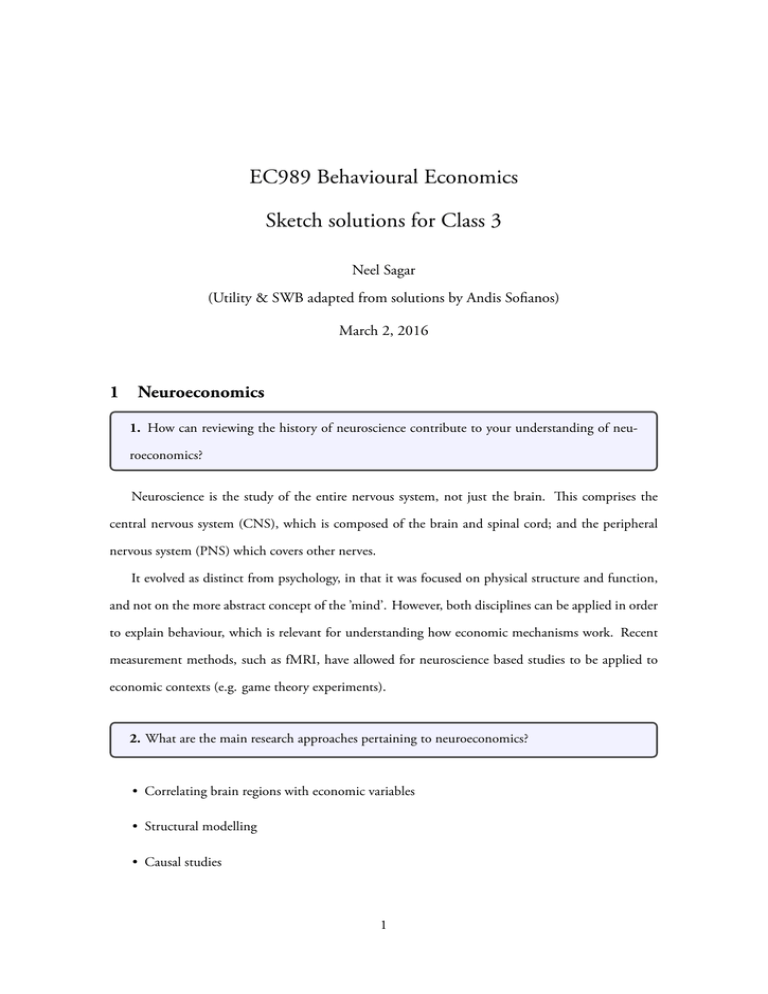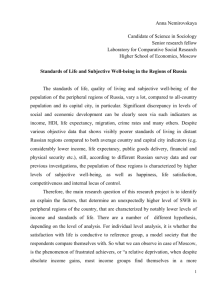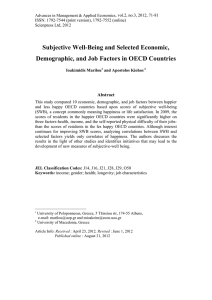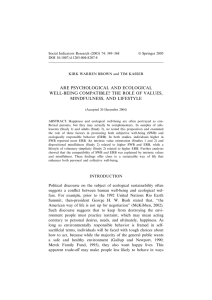EC989 Behavioural Economics Sketch solutions for Class 3 1 Neuroeconomics Neel Sagar
advertisement

EC989 Behavioural Economics Sketch solutions for Class 3 Neel Sagar (Utility & SWB adapted from solutions by Andis Sofianos) March 2, 2016 1 Neuroeconomics 1. How can reviewing the history of neuroscience contribute to your understanding of neuroeconomics? Neuroscience is the study of the entire nervous system, not just the brain. This comprises the central nervous system (CNS), which is composed of the brain and spinal cord; and the peripheral nervous system (PNS) which covers other nerves. It evolved as distinct from psychology, in that it was focused on physical structure and function, and not on the more abstract concept of the ’mind’. However, both disciplines can be applied in order to explain behaviour, which is relevant for understanding how economic mechanisms work. Recent measurement methods, such as fMRI, have allowed for neuroscience based studies to be applied to economic contexts (e.g. game theory experiments). 2. What are the main research approaches pertaining to neuroeconomics? • Correlating brain regions with economic variables • Structural modelling • Causal studies 1 3. What does economics mean? Why should we bother to study the brain (and beyond)? Dictionary definition of economics: The branch of knowledge concerned with the production, consumption, and transfer of wealth. Goal of economics: To improve conditions of people in their everyday lives. Famous definition by Lionel Robbins (1932): Economics is a science which studies human behaviour as a relationship between ends and scarce means which have alternative uses. There seem to be multiple views regarding what economics is and what it should be. However, most of them mention some sort of understanding of human behaviour as a core, as it pertains to choices and decisions. Neuroscience has to potential to help us understand more precisely how decisions are being made, in order to better inform our models of how people act in economic contexts. 2 Utility and Subjective Well-being 1. How would you argue that indices of SWB contain useful information for economics? Indices of SWB have been found to correlate with objective measures like for example heartbeat, income, sociability, self-reported health, sleep quality, personality, and physical evidence of affect like smiling or laughing. 2. According to Benjamin et al., to what extent would you say that SWB and Utility coincide? In Benjamin et al (2012) they directly try to examine the presence of discrepancy between SWB and preferences. To do so they devised 13 hypothetical scenarios in which they ask participants which of two options would provide higher SWB, and which they would actually choose, given the option. There were three different forms of SWB that were elicited: 2 • Life satisfaction: Between these two options, which do you think would make you more satisfied with life, all things considered? • Happiness with life as a whole: Between these two options, taking all things together, which do you think would give you a happier life as a whole? • Between these two options, during a typical week, which do you think would make you feel happier? On average, 83% of choices matched what people thought would give them higher SWB. A common violation of this was observed when income was higher, but some qualitative factor was lower, in one of the options. People tend to choose the higher income option, but feel it would give less SWB than the other option. When SWB is controlled for, the other main factors that influence choice are: 1. Family happiness 2. Social status 3. Purpose 4. Control over life Overall, the paper finds that SWB is the strongest explanatory factor for choice by far. Hence, it is a good proxy for choice utility. 3. Can you argue why adaptation and sensitivity to relative income are problematic when one wants to consider SWB as a proxy for utility? Hedonic adaptation is the finding that people’s levels of well-being seem to revert back to some sort of baseline level over time, after some large shock occurs. Started with Brickman et al (1978), but subsequent studies have confirmed some level of adaptation does occur. Blanchflower and Oswald (2004) have found that relative income can actually explain as much or more of the variation in happiness data than absolute income. Size of effect depends on which group you compare your income to (bigger when you consider those in the top quintile). 3 The classic notion of utility in economics prescribes that context should not affect your valuation for something, and that this valuation should not change over time. This means aggregating SWB to create an index of social welfare can become problematic. 4








